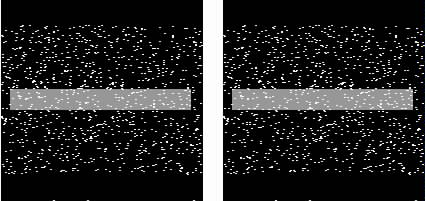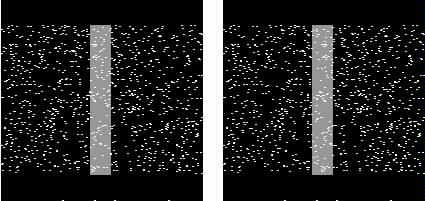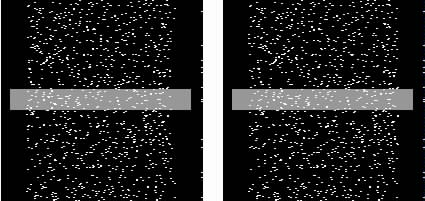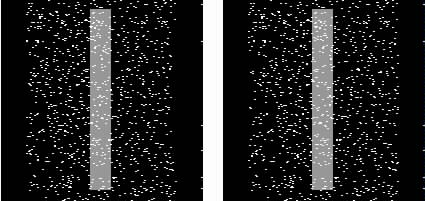
Surface Capture by Stereopsis and by Structure-From-Motion
K. Kham & R. Blake
These QuickTime© animations demonstrate conditions that cause -- and don't cause -- surface capture by structure from motion. In each animation, a central, transparent "ribbon" appears superimposed on a sheet of dots that define a rotating cylinder. The cylinder rotates about either the vertical axis or the horizontal axis; the "ribbon" is elongated either vertically or horizontally. Decide for yourself whether the location in depth of the ribbon (and, hence, its curvature in the case of the horizontal ribbon) coincides with the surface vs the interior of the cylinder.
|
Fixate in the center of the horizontal"ribbon" and click the arrow button on the left to animate the sequence. Does the ribbon appear to adhere to the cylinder's surface or does it appear inside the cylinder? |
Fixate in the center of the vertical"ribbon" and click the arrow button on the left to animate the sequence. Does the ribbon appear to adhere to the cylinder's surface or does it appear inside the cylinder? |
|
Fixate in the center of the horizontal"ribbon" and click the arrow button on the left to animate the sequence. Does the ribbon appear to adhere to the cylinder's surface or does it appear inside the cylinder? |
Fixate in the center of the vertical"ribbon" and click the arrow button on the left to animate the sequence. Does the ribbon appear to adhere to the cylinder's surface or does it appear inside the cylinder? |
These stereograms demonstrate conditions that cause -- and don't cause -- surface capture by stereopsis. In each pair of stereograms, a central, transparent "ribbon" appears superimposed on a sheet of dots whose disparity defines a cylindrical shape. The cylinder's long axis is either horizontal or vertical; the "ribbon" is elongated either vertically or horizontally. Decide for yourself whether the location in depth of the ribbon (and, hence, its curvature in the case of the horizontal ribbon) coincides with the surface vs the interior of the cylinder. (The stereograms were made for cross-eye fusion.)



